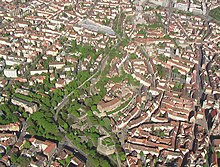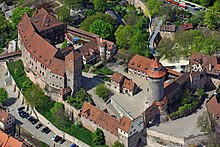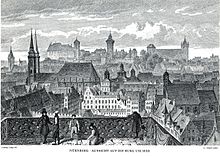Nuremberg Castle
The Nuremberg Castle is the symbol of the city of Nuremberg . It is a double castle and consists of the Kaiserburg and the Burggrafenburg .
The earliest structural traces date from around 1000. After the severe damage caused by the air raids on Nuremberg in World War II , the castle complex was rebuilt in historical forms. With its historical character as a fortification and imperial residence , imperial castle and the seat of the Hohenzollern burgrave, it is one of the most important fortifications in Europe in terms of history and architecture. It is one of the city's most important art and architectural monuments and is part of the Nuremberg Historic Mile .
location
The Nuremberg Castle is located north of the Pegnitz on a sandstone ridge above the old town of Sebald . In the west it borders on the Neutorgraben, in the north on the Vestnertorgraben. The castle is part of the Nuremberg city fortifications to the north . The castle offers a view of the craftsmen's quarter below and the old town.
Overview
In terms of ownership history, the castle consists of three parts, the boundaries of which, however, can only be read with difficulty in today's building stock:
- The remains of the Burggrafenburg with the pentagonal tower are in the middle. The Burggrafenburg was most likely rebuilt in 1192, most of which was destroyed in 1420.
- The Imperial Castle with Sinwell Tower, Deep Well, Double Chapel and Palas extends to the west. The oldest parts date from 1200, after which the castle was continuously expanded and rebuilt.
- Further (imperial) urban buildings are to be found in the north and east (e.g. the former imperial stables of Hans Beheim the Elder and the Luginsland tower ).

In terms of building history, three phases can be distinguished in two main styles:
- in the first half of the 11th century the Salian royal castle in Romanesque style
- around 1200 the Staufer imperial castle in Romanesque style
- in the 15th century the rebuilding of the palace and urban buildings in the Gothic style
Subsequent modifications have changed the original buildings.
In the early days, the imperial castle was the focus of the Hohenstaufen power policy in Eastern Franconia . From 1192 the Burggrafenburg became the starting point for the territorial formation of the Hohenzollern in Franconia, at the same time the imperial city of Nuremberg gained power, fought the Hohenzollern and was able to drive them from the castle in 1427. The city took over the entire castle, which was included in the city fortifications and supplemented with the castle bastions between 1538 and 1545 . Later the castle was increasingly used only for representational purposes. In 1806 Bavaria took over the castle. In the romantic era as well as in the 1930s, the castle was redesigned according to the respective zeitgeist.
During the Second World War , the castle complex was badly damaged by the air raids on Nuremberg, after which it was rebuilt in historical form.
Today the castle is mainly used for tourism.
history
The remains of early buildings discovered in archaeological investigations were dated to before 1000 - but there is no written evidence for this period. Also in the so-called Sigena certificate from Emperor Heinrich III. from the year 1050, nuorenberc is only given as the location of the exhibition, without mentioning whether the castle was referred to as such . After King Konrad II "notarized" on his travels from Regensburg to Bamberg in 1025 and 1030 in Megelendorf an der Pegnitzfurt, today's Mögeldorf , it can be assumed that the Sigena certificate was issued in Nuremberg Castle. The castle does not appear in the sources until 1105. Between that time and 1571, all the emperors and kings of the Holy Roman Empire stayed there temporarily.
Beginning among the Salians
The Salian royal castle was a starting point for Henry III's eastern campaigns . which made Bohemia , Poland and Hungary obligatory. In 1105 the Salian king Heinrich V conquered the castle after a two-month siege in the war against his father, Emperor Heinrich IV. In 1127, King Lothar von Supplinburg besieged the castle, which was defended by the Hohenstaufen brothers Konrad and Friedrich , for ten weeks without success. In 1130 he succeeded in conquering the second attempt and handed the castle over to Heinrich the proud until it fell to the Hohenstaufen in 1138.
Ascent under the Hohenstaufen
The importance of the imperial castle grew under the Staufers, it was extensively rebuilt and, together with the castles Altenburg near Bamberg , Eger and the Wartburg, secured the eastern border of the empire. In 1140 King Conrad III began with the construction of a second castle, the Kaiserburg, which should serve as the royal palace . He lent the newly established burgraviate with court and administration to the noble free von Raabs (from Lower Austria). Friedrich von Zollern inherited it in 1190/91 . In the course of the imperial city independence that Nuremberg achieved in the 13th century, the imperial castle was handed over to the city's care. Emperor Friedrich I. Barbarossa stayed at the castle 12 times, Heinrich (VII.) , Who married at the castle in 1225, 21 times and Friedrich II 16 times. The downfall of the Hohenstaufen (from 1254) left a power vacuum.
Power struggle between the city and Hohenzollern
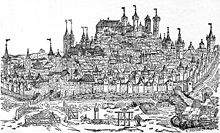
Both the bourgeoisie of the city and the burgraves gained power; their rivalry grew from the 14th century. The burgraves acquired large areas in Franconia and therefore came into conflict with the city. The city wanted to keep the burgraves away from the imperial castle in accordance with the imperial interests. To do this, it made use of structural means: it blocked access to the city and, with the Vestnertor, also blocked access to the north. In 1377 she began building a high tower, the Luginsland, right next to the Burggrafenburg, from which the interior of the castle could be monitored. Complaints from the Hohenzollern to the emperor were unsuccessful. There was open fighting and in 1388/89 the city occupied the Burggrafenburg, but had to vacate it in a settlement. The power of the Hohenzollern in the castle was at a low point when Bavarian troops destroyed the Burggrafenburg in the Bavarian War in 1420 . Then the last burgrave Friedrich VI sold. the destroyed castle in 1427 to the city council of Nuremberg and withdrew to the castle in Cadolzburg . After being enfeoffed with Brandenburg in 1415, the interests of the Hohenzollerns shifted to the north. Although the Franconian Hohenzollern still had the addition of Burggraf zu Nürnberg in their title, this sale meant the end of the existence of the Burggrafschaft Nürnberg. In the period that followed, the two Hohenzollern margravates of Brandenburg-Ansbach and Brandenburg-Kulmbach emerged from their territory .
One anecdote is the legendary jump of the robber baron's horse Eppelein von Gailingen (* around 1320, † 1381) into the moat, with which he is said to have escaped his execution on the gallows .
Representation and loss of meaning
Nuremberg Castle was now completely in the care of the city. During the Hussite Wars , the west and north sides were reinforced and the castle was included in the city fortifications. In 1538–45, the west and north sides were finally secured by the castle bastions . In 1440–42 the Romanesque palace was replaced by a late Gothic new building and in 1487 an extension was added. In 1494/95 the city built the "Kornhaus auf den Vesten", later called the Imperial Stables. In 1524 the city took over the Reformation , which led to an estrangement between the emperor and the city. The living quarters of the castle were redesigned for Emperor Charles V , Ferdinand I had the palace expanded again in 1559/60 , but the castle had lost its importance.
During the Thirty Years' War , the area around Nuremberg was the scene of a multi-year positional warfare between the warring parties, which led to the Battle of the Alte Veste in 1632 . The city and the castle were not conquered. After the war, the castle lost its military importance and the Reichstag no longer took place in Nuremberg, but from 1663 on in Regensburg.
In 1806 the castle and town became part of the Kingdom of Bavaria . In 1828 Kaspar Hauser was housed in prison in the castle for a few weeks.
With the romantic era , a historical interest in the castle arose. Building conservation and redesigning measures began in 1834 under Ludwig I .; The work of Carl Alexander Heideloff , August von Voit and August Essenwein should be mentioned in particular . So was z. For example, a high Söller was added on the west side, local carpenters made historicizing furniture for the interior, but original pieces from other castles (e.g. Willibaldsburg from Eichstätt) were also used.
After the Bavarian defeat in the German War in 1866, Ludwig II had to allow the Prussian King Wilhelm I to share the "castle of his fathers".
After the NSDAP came to power in 1933, work began on converting the imperial castle. As part of the annual Nazi party rallies , the Imperial Castle was intended to serve as a symbolic backdrop for the Nazi regime and as accommodation for high-ranking state guests. The so-called restoration in the sense of a "creative preservation of monuments", in which the historicist furnishings of the castle from the 19th century, perceived as a "weak style costume", was destroyed under the direction of Rudolf Esterer from 1934 onwards. The trade journal Der Baumeister rated the Nazi redesign measures euphorically at the time: “When we visit Nuremberg Castle today, we are no longer greeted by a false theater magic that has nothing to say to us inside, but we experience the old one again at every turn noble imperial castle, which with a powerful size and austere beauty based on its simple design, as a work of rediscovered old, dignified German craftsmanship, casts its spell over us. It is indisputable achievement of the men who have been at work here to have brought this original greatness back to life. "
During the Second World War , the castle suffered severe damage in 1944/45; only the double chapel and the Sinwell tower remained almost intact. In the post-war period, all assemblies were restored in their historical forms, for example Luginsland, which was completely destroyed in the war; however, the interior design of the 19th century, which had been almost completely eliminated in 1934/35, was not reconstructed. Thus, the interior of the castle is largely in the form that Rudolf Esterer's measures gave it.
The long-neglected tourist use of the castle has been attracting more attention since 2013. The permanent exhibition has been redesigned - in addition to the castle, the Holy Roman Empire of the German Nation and the role of Nuremberg in the late Middle Ages are shown. Many buildings and outdoor facilities are to be renovated and the possible uses are to be expanded.
buildings
The list of architectural monuments in Nuremberg / Stadtbefestigung # Burg provides an overview of the buildings .
Imperial Chapel
The double chapel in the Romanesque architectural style was built around 1200 and is therefore one of the oldest parts of the castle still in existence (see # Archaeological investigations and "Castle 16" under the list of architectural monuments in Nuremberg # Kaiserburg ). In the chancel there is a crucifix by Veit Stoss , a work of the late Gothic .
Access to the upper chapel was reserved for the high nobility . The lower chapel can only be reached from the inner courtyard. The lower and upper chapels are only connected by a ceiling opening. The imperial family took their seats on the west gallery of the upper chapel, with a separate area for the emperor. The three levels thus represent the hierarchy of society at that time.
In 1216, the construction work on the castle came to an end and Emperor Friedrich II assigned the lower part of the double chapel, the so-called Margaret Chapel, to the branch of the Teutonic Order , which it probably held until 1419 and then handed it over to the city of Nuremberg.
- Imperial Chapel
Fountain
The water supply to the castle was secured by two castle wells in the event of a siege . The fountain of the former Burggrafenburg is located a few meters south of the pentagonal tower. The draw well, which is about 20 meters deep, drew water from the base of the Lower Burgsandstein .
The deep well of the Kaiserburg is probably as old as the castle itself. The shaft was carved into the rock and has a diameter of 2.2 to 1.7 and a depth of 53 meters. It leads through layers of castle and parlor sandstone to the bubble sandstone with the Pegnitz water table .
Bastions
In the 16th century the fortifications had to be reinforced. As early as 1527, a mighty round bastion was built at the northeast corner of the city wall - outside the castle - the Kübler Zwinger , also known as the Dürerbastei.
Between 1538 and 1545, three large castle bastions (Vestnertor-, Large and Lower Bastion) were built directly to the northwest in front of the castle according to the plans of the Italian fortress engineer Antonio Fazuni . These structures should strengthen the castle and city fortifications because of the penetration power of the advanced artillery .
Imperial stables
In the east of the castle, the "Kornhaus auf den Vesten" was built by Hans Beheim the Elder in 1495 between the Luginsland tower and the five-cornered tower, a two-story stone building with five lofts on top of each other. It served as the town's granary; the rooms on the ground floor were also used as stables during the imperial era.
The building was converted into the Reich Youth Hostel in 1937, destroyed in World War II and rebuilt in 1953. The Kaiserstallung is still used today as a youth hostel and after the last renovation it has 93 rooms.
Archaeological research
In 1990, in the course of renovations in the knight's hall of the imperial castle, the foundations of a Salian round chapel were found. In 2001 the remains of a Salian keep with two meter thick walls and a defensive wall were discovered in the courtyard of the castle . This plant is dated around the year 1000 or a little earlier. Even older foundations were found under the foundations of this former keep, which presumably date back to pre-Sali times.
Excavations in the castle courtyard have revealed traces of human settlement from before 1000. The foundation of a round tower with a wall thickness of two meters was excavated, which, according to the Bavarian State Office for Monument Preservation, was also built before 1000.
What is certain is that the castle stretched across the castle hill from east to west as early as the 11th century; At least since the 12th century, the Burggrafenburg had been in front of the actual castle of the emperor to the east like a bolt.
The oldest surviving building, the double chapel with the eastern choir tower (Margarethenturm, also known as the " Heidenturm " as a supposedly Roman building , see Regensburg's "Heidenturm" ) was probably built in the second quarter of the 13th century and shows architectural decorations in the forms of late Romanesque.
(In Matthäus Merian's Topographia Franconiae , the Roman military leaders Nero Claudius Drusus - † 9 BC - and Tiberius Claudius Nero - emperor from 14 AD - are considered to be the builders of the “Pagan Tower”, perhaps on the occasion of a campaign in the Germania magna . At that time the Rhaetian Limes did not yet exist, and the Romans had only just been able to secure the banks of the Danube . Expansion across the Danube to the north had to be abandoned in the 3rd century, until it collapsed in the 5th century only today's Regensburg will be held as the closest place to Nuremberg. This is about the keyword Neroburg in connection with speculative interpretations of the name of the city of Nuremberg in the second millennium AD.)
tour
Coming from the city, you normally leave the Himmelstor on the Mount of Olives to the left and continue up the ascent towards the former imperial stables (now a youth hostel), at the east end of which the Luginsland towers high. To get to the castle, turn left (to the west) past the pentagonal tower in front of the imperial stables and, before passing the first gate, you can visit the Walburgis chapel rising over the steep slope from the outside.
If you then pass the first gate, you have to orientate yourself again to the left (straight ahead you get to the moat on the north side) and reach the clearing , from which the old town and, if the weather is clear, the eastern, southern and western city quarters can be seen well .
The clearance (also: castle clearance) is in front of the Walburgis chapel. It separated, formerly belonging to the Burggrafenburg, this from the Imperial Castle. Here persecuted people enjoyed the right of asylum (exemption) , according to medieval law . From the clearing, the circular route continues through the castle gate under the “Secret Guardian Walk ”. Immediately after the gate on the right rises the 41 meter high round Sinwell Tower, which can be climbed as a viewing tower as part of a guided tour ; access to the deep well is also possible. On the left is the sky stables and the sky gate, through which you can also enter the courtyard. If you continue west towards the inner castle gate, you will pass the double chapel with the Heidenturm.
From the inner courtyard you have access to the Imperial Castle as part of a guided tour, while the Castle Museum as a branch of the Germanic National Museum can be viewed separately.
On the way back you can look at the possibly overlooked outbuildings and walk north across the moat to be impressed by the mighty bastions.
If you want to continue on an extended tour, you go outside the city wall to the Tiergärtnertor , where you can enter the castle garden through the wall in summer . It extends on the north side of the castle almost to the pentagonal tower. On the Vestnertorbastei there is the monument of Georg Christoph Eimmart , who built the first observatory in Nuremberg at this point. The exploration tour ends there. The Albrecht Dürer House is located near the castle .
Since June 2013, an official digital tour has also been available free of charge for iPad users via the Kaiserburg app.
present
The building is owned by the Bavarian Palace Administration and is primarily used for tourist purposes. Individual buildings are also used as residential, official or museum buildings as well as temporarily for parties and state receptions. One of the largest and most modern youth hostels in Germany is located in the old imperial stables . The house with 355 beds was reopened in spring 2013 after renovation.
Castle habitat
Due to its structural situation, the Nuremberg Imperial Castle is of great importance as a habitat for animals and plants. The large number of cellars, walls, towers and green areas offer diverse habitats for flora and fauna. As part of the "Burg Habitat" project, biologists have so far identified around 1400 animal and plant species in the area of the Nuremberg Imperial Castle in mapping over an area of around 65,000 square meters - an impressive biodiversity.
geology
The sandstone rock is designated as Geotope 564A002 by the Bavarian State Office for the Environment . The geotope is also one of the 100 most beautiful geotopes in Bavaria . See also the list of geotopes in Nuremberg . The geotope is the type locality for the castle sandstone named after it , a geological layer unit of the Keuper , which is widespread in Franconia .
Flagging the castle
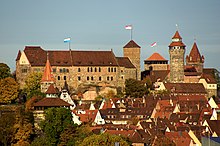
Since summer 2008, the Bavarian and German flags have been flying on Nuremberg Castle (as on official buildings of the Free State) by order of the Bavarian Ministry of the Interior . Nuremberg SPD city councilors requested the Free State to also raise the Franconian flag . However, the request was rejected by the Bavarian Interior Minister Joachim Herrmann . In the summer of 2009 the flag dispute was settled. However, the Franconian flag was not hoisted: since July 15, 2009, the flag of the city has been flying on the five-cornered tower, which also contains the Franconian colors red and white. In the summer of 2012, the flag changed again: on the main building (Palas) of the castle the German flag was replaced by the Bavarian flag. For this, the Franconian flag was hoisted on the former place of the Bavarian flag (Heidenturm). The black-red-gold flag is now flying on a specially erected mast in the clearing.
Cultural use
In the moat to the north of the castle, music events took place in the 1980 / 1990s, which are no longer possible today due to the narrow access routes. These included:
- Rock in the moat
- a central stage of the Bardentreffen
The following are organized today (as of 2014):
- Castle Festival
- Medieval market
- Beer festival
In 2013 the special exhibition Kaiser-Reich-Stadt took place, which, with only minor changes, was converted into a permanent exhibition.
During the Blue Night , a city-wide cultural festival, the castle is the scene of elaborate projections as part of art installations:
- 2007: Installation Once upon a time by Katja Then
- 2008: Sound and light symphony Lichtinseln
- 2009: Installation Light Drops by Elke Harras
- 2010: Art flu - infected by pep Berlin
- 2011: Expedition - Foreign Worlds by Lisa Lang, technical implementation by Rezac from Vienna
- 2012: Master Noris by Gerd Bauer
- 2013: AD ASTRA by Julian Vogel
- 2014: The dreams of Mr. Who by Anna Bittersohl
- Sporting use
The District Ride in Nuremberg was held for the first time in September 2005 , a freeride mountain bike event with 40,000 to 60,000 spectators. The start was at the castle, the goal was the main market . Due to the unexpected success, the major sporting event was repeated in 2006, 2011 and 2014 and took place for the 5th time in 2017.
See also
- History of the city of Nuremberg
- Art and architectural monuments of the city of Nuremberg
- Castles, palaces and mansions in Nuremberg
- Fortress Lichtenau , southwest of Nuremberg, built by Nuremberg until 1630
- Wenzelschloss in Lauf an der Pegnitz , east of Nuremberg, built in 1356 by Charles IV , fell to Nuremberg in 1504
literature
- Ernst Mummenhoff : The Nuremberg Castle. Historical guide for locals and foreigners. 4th edition. Schrag, Nürnberg 1926. (Reprinted with an afterword by the new editor G. Ulrich Großmann . Verlag des Germanisches Nationalmuseums, Nürnberg 1997, ISBN 3-926982-52-7 , with a selection bibliography on recent literature)
- Gerhard Pfeiffer: Studies on the history of the Palatinate Nuremberg. In: Yearbook for Franconian State Research. 19, 1959, ISSN 0446-3943 , pp. 303-366.
- Günther P. Fehring, Anton Ress: The city of Nuremberg. Brief inventory. (= Bavarian art monuments. 10). 2nd Edition. edited by Wilhelm Schwemmer. Deutscher Kunstverlag, Munich 1977, ISBN 3-422-00558-7 , pp. 152–165, (Unchanged reprint. Ibid 1982).
- Heinz-Joachim Neubauer: The construction of the large bastion behind the fortress 1538–1545. In: Communications from the Association for the History of the City of Nuremberg. 69th Volume, Nürnberg 1982, pp. 196-263.
- G. Ulrich Großmann , Birgit Friedel: The Imperial Palace Nuremberg. (= Castles, palaces and defensive structures in Central Europe. 1). Schnell & Steiner, Regensburg 1999, ISBN 3-7954-1216-1 .
- Ulrich Großmann: The Imperial Castle in Nuremberg. Literature report and research status. In: G. Ulrich Großmann (Red.): Castle building in the 13th century. (= Research on castles and palaces. 7). Published by the Wartburg Society for Research into Castles and Palaces in conjunction with the Germanic National Museum. Deutscher Kunstverlag, Munich a. a. 2002, ISBN 3-422-06361-7 , pp. 83-98.
- Alexander Thon: … ut nostrum regale palatium infra civitatem vel in burgo eorum non hedificent. Studies on the relevance and validity of the term “Palatinate” for the exploration of castles of the 12th and 13th centuries. In: G. Ulrich Großmann (Red.): Castle building in the 13th century. Published by the Wartburg Society for Research into Castles and Palaces in conjunction with the Germanic National Museum. Deutscher Kunstverlag, Munich a. a. 2002, ISBN 3-422-06361-7 , pp. 45-72.
- André Fischer: New book on the history of Nuremberg's landmark. Did Schweinfurters found the castle? Review in: Nürnberger Zeitung. No. 74 of March 29, 2007, p. 11 (with photos) - (online)
- Birgit Friedel: The Nuremberg Castle. History, building history and archeology . (= Writings of the German Castle Museum. 1). Imhof-Verlag, Petersberg 2007, ISBN 978-3-86568-036-5 . (At the same time: University of Bamberg, dissertation 2005), (+ 1 CD-ROM).
- Hans Gaab, Uwe Lemmer, Ekkehard Wagner (Hrsg.): Astronomy on the Imperial Castle Nuremberg. Europaforum-Verlag, Lauf ad Pegnitz 2007, ISBN 978-3-931070-49-6 .
- G. Ulrich Großmann: Die Kaiserpfalz Nürnberg Verlag Schnell & Steiner, Regensburg 2013, ISBN 978-3-7954-1876-2 .
Web links
The Nuremberg Castle as a 3D model in SketchUp's 3D warehouse
- Historical lexicon of Bavaria
- Nuremberg Castle on the website of the House of Bavarian History (plans, history, building history, existing buildings)
- Kaiserburg Nürnberg on burgseite.de
- Era: Renaissance, large castle bastions (photos, at baukunst-nuernberg.de)
- Photos of paintings inside
- Photos of paintings inside
- The biodiversity project "Burg Habitat"
- Geological / archaeological exploration of the "Tiefen Brunnen" on the Imperial Castle in Nuremberg
Individual evidence
- ^ Günther P. Fehring, Anton Ress: The city of Nuremberg. 2nd Edition. edited by Wilhelm Schwemmer. Deutscher Kunstverlag, Munich, ISBN 3-422-00550-1 , p. 152ff.
- ↑ a b c d Imperial Castle Nuremberg, official guide, 1994.
- ↑ Document 253 in Harry Bresslau and Paul Kehr (eds.): Diplomata 16: The documents of Heinrich III. (Heinrici III. Diplomata). Berlin 1931, pp. 336–337 ( Monumenta Germaniae Historica , digitized version )
- ↑ Document 30 in Harry Bresslau with the assistance of H. Wibel and A. Hessel (eds.): Diplomata 15: The documents of Konrad II. (Conradi II. Diplomata) With supplements to the documents of Heinrich II. Hanover 1909, p. 33 –34 ( Monumenta Germaniae Historica , digitized version )
- ^ Photo of the moat at Vestnertor, into which the robber knight Eppelein von Gailingen jumped on his horse
- ↑ a b c d page of the Bavarian castle administration to the castle
- ^ The restoration of the imperial castle in Nuremberg , in: Der Baumeister , 33rd year, June 1935, issue 6, pp. 185–195 and plate 67, here p. 190.
- ↑ Flyer of the Bavarian Palace Administration (PDF file; 237 kB)
- ↑ Imperial Castle Nuremberg Double Chapel (Margaretenkapelle) Source: Bavarian Palace Administration
- ↑ Birgit Friedel: Nuremberg Castle. In: Historical Lexicon of Bavaria . Retrieved May 12, 2016 .
- ^ Alfons Baier: the two fountains of Nuremberg Castle. Erlangen, 1998.
- ↑ The three big bastions at nuernberg-aha.de
- ↑ Article in the SZ , accessed on March 11, 2015
- ^ Alfons Baier: On the history, geology and hydrology of the castle hill in Nuremberg. In: Geological sheets for northeast Bavaria and neighboring areas. 4, 1988, pp. 277-300. ( Short version )
- ↑ Herbert Maas: Is Nuremberg the "Castle of Noro" or the castle on the Felsberg? In: Communications from the Association for the History of the City of Nuremberg . tape 77 , 1990, pp. 1–16 ( digitized version - see point 1 on p. 2).
- ↑ Matthäus Merian (ed. And illustrator), Martin Zeiller (text): Topographia Franconiae , entry Nuremberg. Frankfurt 1648; Entry online on Wikisource . (In one of the variants it goes "against the King of Thuringia", cf. Roman marching camp at Hachelbich and Hermunduren .)
- ↑ Our castle> towers on nuernberg.de, page 7/8 (PDF; 1.5 MB)
- ↑ The Imperial Castle. The Legacy of the Castle Guardian. From the Bavarian State Ministry of Finance. On: Apple AppStore , accessed August 5, 2013.
- ↑ Portrait of JuHe Nürnberg , jugendherberge.de, accessed on June 30, 2013.
- ↑ Lebensraum-burg.de
- ↑ Geotope Cadastre Bavaria: Sandstone rocks near the Nuremberg Imperial Castle , accessed on October 12, 2013 (PDF file; 328 kB)
- ^ Sandstone cliffs Nuremberg Imperial Castle , accessed on October 12, 2013
- ^ No Franconian flag on the Nuremberg Imperial Castle. In: tz.de. Zeitungsverlag tz München GmbH & Co. KG, March 8, 2009, accessed on October 2, 2017 .
- ↑ Isabel Lauer: Now the city flag also adorns the castle. All good things come in three flags. In: nordbayern.de. Verlag Nürnberger Presse Druckhaus Nürnberg GmbH & Co. KG, July 16, 2009, accessed on October 2, 2017 .
- ↑ blauacht.nuernberg.de
- ↑ blauacht.nuernberg.de
- ↑ blauacht.nuernberg.de
- ↑ blauacht.nuernberg.de
- ↑ blauacht.nuernberg.de
- ↑ blauacht.nuernberg.de
- ↑ blauacht.nuernberg.de
- ↑ blauacht.nuernberg.de
- ↑ September 2017: 5th District Ride in Nuremberg
Coordinates: 49 ° 27 ′ 28.3 " N , 11 ° 4 ′ 33.3" E

